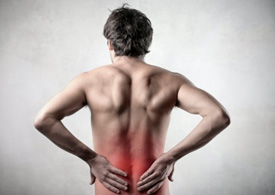People will often present to my office for the treatment of sciatica, which is pain typically felt in the buttock, upper thigh and sometimes below the knee.
The true definition of sciatica simply means leg pain, being referred from the irritation upon one of the five nerve roots which make up the sciatic nerve, or the sciatic nerve itself.
 This irritation can be the result of a disc bulge, or herniation, whereby pressure from the disc is pinching one of the nerve roots as it exits the spine. The compression on the nerve can create pain, numbness and even weakness in the leg. However, it is far more common that the sciatic pain these patients are feeling stems from muscles in and around the hip and pelvis that are compressing the sciatic nerve combined with joint dysfunction in the hip, sacroiliac joint and lumbar spine joints. As each segmental unit introduces dysfunction into a persons movement, the effect accumulates, passing more and more tension onto the sciatic nerve.
This irritation can be the result of a disc bulge, or herniation, whereby pressure from the disc is pinching one of the nerve roots as it exits the spine. The compression on the nerve can create pain, numbness and even weakness in the leg. However, it is far more common that the sciatic pain these patients are feeling stems from muscles in and around the hip and pelvis that are compressing the sciatic nerve combined with joint dysfunction in the hip, sacroiliac joint and lumbar spine joints. As each segmental unit introduces dysfunction into a persons movement, the effect accumulates, passing more and more tension onto the sciatic nerve.
What can you do to treat sciatica?
1. Staying mobile, active and avoiding bed rest are keys to the recovery of any low back related pain.
2. Staying adequately hydrated is also important. As hydrated tissue is more flexible, it will respond better to stress and strain. When dehydrated, your tissues become more stiff and rigid. Therefore, drinking more water will help your flexibility and movement.
3. Frequently stretching the tight muscles of your hip and pelvis (as directed by your Doctor of Chiropractic or Registered Massage Therapist) will help to reduce the tissue tension and restore your mobility. Most importantly, keeping up these regimes after the pain has subsided will help to minimize the risk that your sciatica will return.
4. Consider your foot wear. Wearing supportive footwear will significantly reduce strain to your lower back and hips, especially if you have fallen arches. When the arch of the foot drops, it causes the leg to rotate inwards slightly. When this motion gets to the hip, it causes the pelvis to tilt posteriorly (meaning your tail bone flares outwards). This automatically increases the curve in your lumbar spine, and increases the tension in the posterior pelvic and hip muscles. This mechanical change will increase your sciatic symptoms. The take home point? No flip flops, flats, heels, untied sneakers or loose fitting boots.
5. Working with a chiropractor has been shown to significantly reduce sciatic pain. Also, as your chiropractor will help you identify deficits in your movement patterns and spinal/hip mechanics, you can even reduce your risk of it returning in the future. While self stretching programs are important, it is important to have a person working with you to help identify and correct problems you may encounter during the healing process. Most importantly, through assessment, a chiropractor will be able to identify areas of tissue and joint tension and help to correct them at each visit.
 Request Appointment
Request Appointment Email Us
Email Us